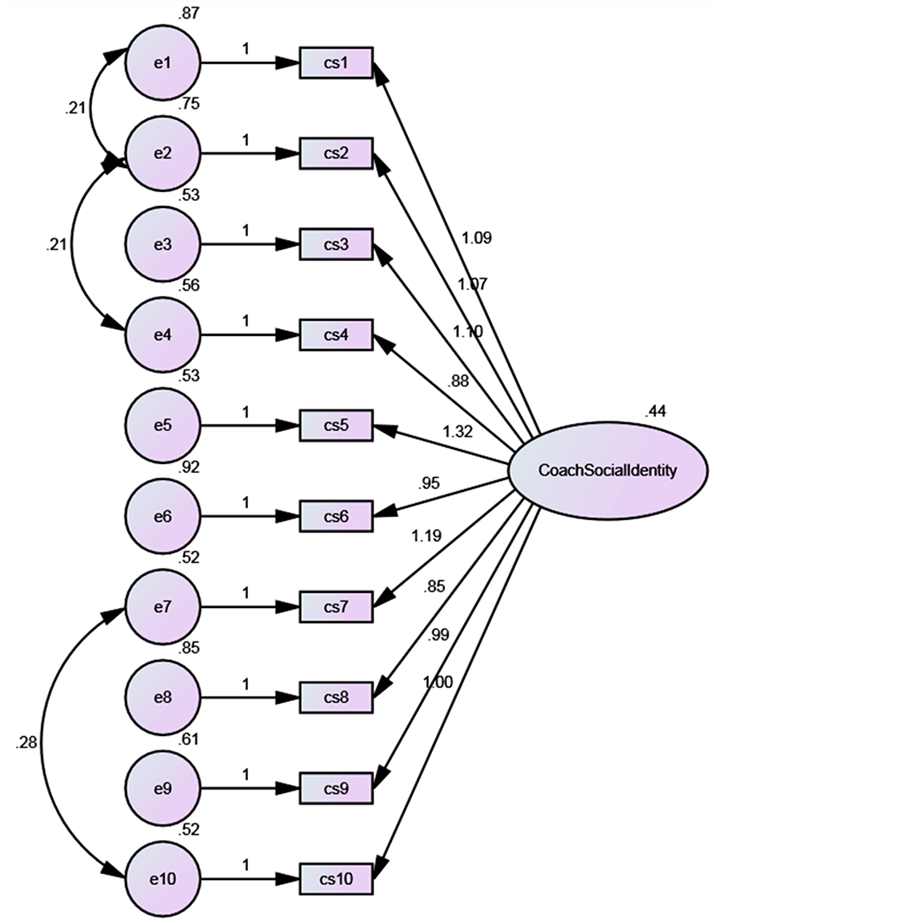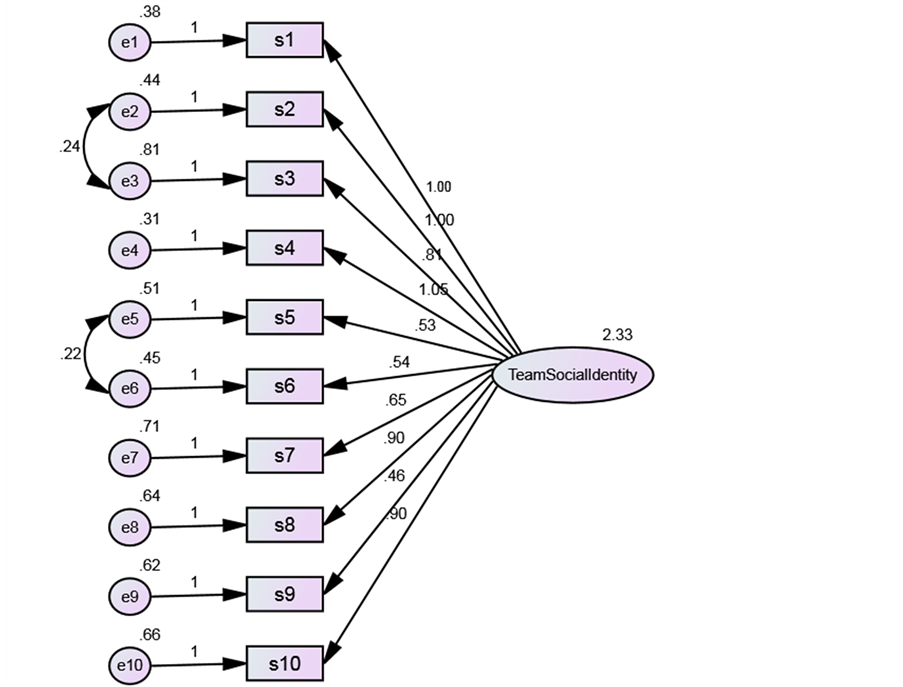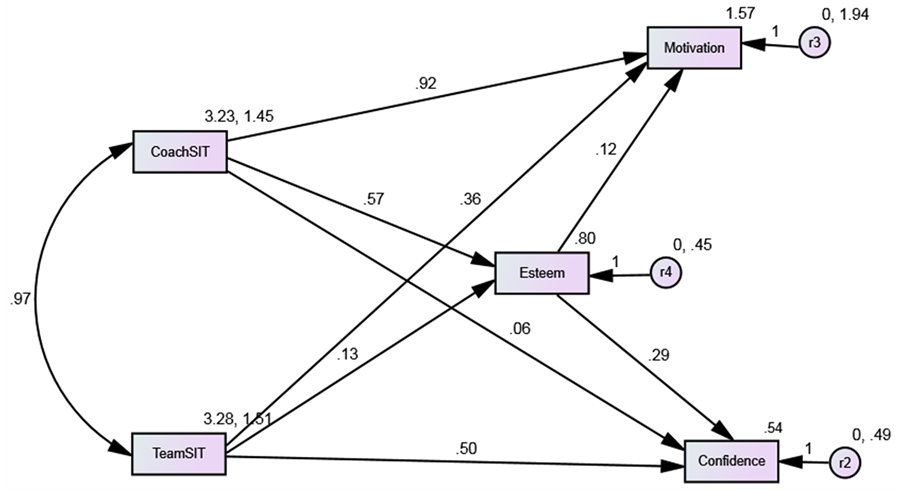Perceptions of Coach Social Identity and Team Confidence, Motivation and Self-Esteem ()
1. Introduction
Chelladurai and Saleh (1980) were among the first to argue the utility of applying Leadership Theory in sport and since then a number of studies have explored this relationship (e.g. Callow, Smith, Hardy, Arthur, & Hardy, 2009; Charbonneau, Barling, & Kelloway, 2001; Miller & Carpenter, 2009; Rieke, Hammermeister, & Chase, 2008; Smoll & Smith, 1989). Though these studies demonstrate to some degree the effectiveness of leadership models in explaining coaching behavior and performance, definitions of coach leadership fail to reflect a true understanding of either the coaching process or leadership (Vella, Oades, & Crowe, 2010). The limitations in terms of definition are further linked to both the measurement and application of coach leadership theory. Studies cited above have looked at cognitive-mediational models (Smoll & Smith, 1989), transformational leadership models (Callow et al., 2009; Charbonneau et al., 2001) and more recently servant leadership (Rieke et al., 2008), altruistic models (Miller & Carpenter, 2009), and authentic leadership (Luthans & Avolio, 2003). One promising perspective that seems to have been missed or ignored is the social identity theory of leadership (Ellemers, De Gilder, & Haslam, 2004; Haslam & Platow, 2001; Hogg, 2001, 2006, 2007; Hogg, Fielding, Johnson, Masser, Russell, & Svensson, 2006).
Current definitions of leadership as a relational, strategic, and complex social process have exposed the limitations of traditional models (Avolio, Walumbwa, & Weber, 2009; Haslam, Reicher, & Platow, 2011; Vroom & Yago, 2007), and provided a suitable breeding ground for a Social identity perspective. Social identity theory refers to, “the individual’s knowledge that he belongs to certain social groups together with some emotional and value significance to him of this group membership” (Tajfel, 1982: p. 292). Sharing this sense of identity creates cohesion within a group and essentially motivates individuals to go the extra mile to defend and enhance a positive identity for the group; the individual’s self-esteem depends on a strong, positive identity for salient groups, e.g. their football team (see Hogg, 2001; Hogg & Abrams, 1990). An effective leader will need to be seen to share the group identity, i.e. to espouse the shared values, attitudes, beliefs and desires; in other words to be seen as a group member (Hogg, 2001). Group members will hold a prototype of a typical group member and the closer any individual matches the prototype the more they will be liked and respected, i.e. they become socially attractive. This combination of social attraction and prototypicality enables individuals to emerge or operate as leaders, exerting social influence on the group (Hogg, 2001). This model of leadership has been tested in numerous studies (Ellemers et al., 2004; Haslam et al., 2011; Haslam & Platow, 2001) and shown to impact on motivation, performance, and team cohesion. In addition to leadership currently being defined as a complex social process, so too is coaching. Vella, Oades and Crowe (2010) define coaching as, “complex social process that is constituted and maintained by a set of reciprocal, interpersonal relationships and permeated by contextual constraints” (p. 425). It seems to follow that a social process model of leadership is more likely to be useful as a model in coaching.
In order to explore a social identity theory of leadership in coaching there is the issue of measuring social identity. Most of the studies that have tested the theory in work settings have been experimental studies which are not easily undertaken in real world settings. Hence a questionnaire measure is desirable. A literature search identified 13 possible scales (see Table 1) and these were reduced to 6 which were finally used in developing items for the current study. These were, 1) the Collective Self-Esteem Scale (CSES) (Luhtanem & Crocker, 1992), 2) the 3-component Social Identification Measure (Ellemers, Korkenaas, & Ouwerkerk, 1999), 3) Karasawa’s (1991) 2-component measure of social identity, 4) Mael and Asforth’s (1992) 6-item measure of global organizational identification, 5) Doosje, Ellemers, and Spears’ (1995) 4-item global identification measure, and 6) Hinkle, Taylor, Fox-Cardamone, and Crook’s (1989) 3-component SI measure.
Evidence suggests that the social identity approach to leadership provides a useful model for understanding and developing effective coaching, yet it has not been applied to the area. In order to apply it there is a need to develop a measure. Drawing on existing measures of social identity developed for use in work settings the current study aimed to devise a pool of items from which to develop measures that can be used to assess a social identity model of leadership in coaching settings. The aim is to devise measures that can be applied to both coaches and team members, and test the utility of that measure.
2. Method
2.1. Design and Sample
A survey using questionnaire data collection was administered to 271 sport science students (229 males and 42 females) ranging in age from 18 - 38 (Mage = 21.5, SDage = 4.5).
2.2. Measures
A pool of 51 items was derived from the 6 measures described in Table 2, after duplicate items were removed. The items were revised so as to be applicable to a sport setting, and could be used to reflect team members’ perceptions of their coach. For example “It would be accurate to describe our coach as a typical member of our team” or “I identify with my team coach”. The items were presented with a 5-point Likert scale from 1 (strongly agree) to 5 (strongly disagree).

Table 1. Scales accessed in constructing an item pool for the current study.
Note: * is used to identify scales used in the construction of the item pool.

Table 2. Factor loadings and psychometric properties of the Coach Social Identity Scale (CSIS).
In order to measure team member’s sense of identification with the team the same pool of 51 items was also reworded to be applicable to team members’ ratings of their own relationship with their team. For example “It would be accurate to describe me as a typical member of our team” or “I identify with my team”. The items were presented with a 5-point Likert scale from 1 (strongly agree) to 5 (strongly disagree).
In addition 2 standardised measures, as described below, were used.
The Sport Motivation Scale (Pelletier, Fortier, Vallerand, Briere, Tuson, & Blais, 1995). The Sport Motivation Scale (SMS) is a measure of contextual motivation which is intended to identify the perceived reasons for participating in sport. It measures the three forms of motivation, intrinsic motivation (α = .82), extrinsic motivation (α = .85), and amotivation (α = .71), reflecting varying degrees of self-determination along a motivation continuum (Deci & Ryan, 1985). Participants are asked to respond to the question, ‘‘Why do you practice your sport?’’ with such items as, ‘‘for the pleasure I feel in living exciting experiences’’. Participants respond using a sevenpoint Likert-type scale ranging from 1 (does not correspond at all) to 7 (corresponds exactly).
The Carolina Sport Confidence Inventory (CSCI) (Manzo, Silva, & Mink, 2001) is a 13-item scale based on a two-factor model incorporating sport optimism (α = .79), and sport confidence (α = .87) as a composite of perceived competence and perceived control. Participants are presented with 13 pairs of opposing statements to choose between and then indicate whether it is somewhat or very true for them. See example of item 1 below.
2.3. Procedure
Convenience sampling was used to distribute questionnaires to 450 sport science students, from whom 271 completed measures were received, approximately 60% response. Data was entered into SPSS for analysis.
3. Results
A principal component analysis (PCA) with orthogonal rotation (varimax) into simple structure was conducted on the 51 items devised to reflect team members’ perceptions of their coach. The Kaiser-Meyer-Olkin measure verified the sampling adequacy for the analysis, KMO = .95. Bartlett’s test of sphericity, χ2(1275) = 7368.03, p < .001 indicated the correlations sufficiently large for PCA. An initial analysis was run to obtain eigenvalues for each component and eight of these delivered eigenvalues over Kaiser’s criterion of 1. In combination these eight components explained 71.6% of the variance. However the scree plot and eigenvalues suggested a 4 factor solution accounting for 58.5% of the variance was acceptable as shown in Table2 The first factor accounted for 30.3% of the variance on its own and the items loading on it clearly represent evaluations of the coach in terms of social identity with the team. The other three factors reflected evaluations of the coach as positive, negative, and respected respectively. However as the aim of this study was to develop a social identity leader scale, the first factor was focused on for the rest of the analysis.
We used the set of criteria proposed by Lamping, Schroter, Marquis, Marrel, Duprat-Lomon, and Sagnier (2002) and summarised by Smith, Lamping, Banerjee, Harwood, Foley, Smith et al. (2005) to set out some of the psychometric properties of the data for the social identity factor (see Table 3). The data used in this study was based on a cross sectional survey so test-retest reliability was not tested. However the items and factors perform well on all the other dimensions as shown in Table3
Next a principal component analysis (PCA) with orthogonal rotation (varimax) into simple structure was conducted on the 51 items reflecting team members’ perceptions of their own relationship with their team. The Kaiser-Meyer-Olkin measure verified the sampling adequacy for the analysis, KMO = .93. Bartlett’s test of sphericity, χ2(1275) = 9986.048, p < .001 indicated the correlations sufficiently large for PCA. An initial analysis was run to obtain eigenvalues for each component and eight of these delivered eigenvalues over Kaiser’s criterion of 1. In combination these eight components explained 67.4% of the variance. However the scree plot and eigenvalues suggest that only 3 factors accounting for 51.1% of the variance was identifiable. Scrutiny of the items loading on these factors suggest that the first factor accounting for 30% of the variance was the clearest measure of social identification with the team, and this 15-item factor is shown in Table4
Again using the criteria proposed by Lamping et al. (2002) and summarized by Smith et al. (2005), the items and factors perform well as shown in Table4
Pearson Product Moment Correlations between the new scales and the measures of sport confidence and sport motivation were calculated as shown in Table5

Table 3. Factor loadings and psychometric properties of the single factor Team Social Identity Scale (TSIS).

Table 4. Psychometric criteria and scale performance for the CSIS and the TSIS.

Table 5. Correlations and descriptive statistics.
Note: *p < .01; **p < .001.
Firstly the significant positive correlations between the two scales provide some evidence of concurrent validity as one might expect a positive relationship between perceptions of the coach as a prototypical team member and ratings of one’s own identification with the team. Further evidence of concurrent validity is provided by the positive correlations between both scales and ratings of the coach as positive, and respected, and the negative correlations with ratings of the coach as negative. Finally the fact that both higher ratings of the coach as a prototypical team member and self identification with the team correlated positively with sport confidence, sport optimism, and intrinsic and extrinsic motivation provides additional evidence of predictive validity.
In order to further test the structure of the scales Confirmatory Factor Analysis was carried out using AMOS, which produced the results shown in Figure 1 and Figure 2. The Fit Indices confirm the fit of both measures to the data.
Finally since the correlation analysis shows a significant relationship between both Coach Social Identity (CSI) and Team Social Identity (TSI) and sport motivation and sport confidence a model was developed and tested using Structural Equation Modelling (SEM) with AMOS. The model proposed that CSI and TSI would both show positive and significant relationships with both sport motivation and sport confidence allowing TSI and CSI to be correlated and also allowing sport motivation and sport confidence to be correlated. The results shown in Figure 3 confirm that the model is a good fit for the data.
4. Discussion
The aim of this study was to develop and test measures which could be used in further exploring the utility of a social identity theory of leadership in sport coaching and this has been successfully accomplished. The pool of

Figure 1. Confirmatory factor analysis of the Coach Social Identity Scale. Chi-square (32) = 61.357, p < .001 (CMin/df = 1.9); CFI = .98; IFI = .98; RMSEA = .05 (Cl: .03 - .08); SRMR = .04.
items devised to provide team member ratings of their coach produced 4 factors, the first of which clearly reflects ratings of the coach as a prototypical team member and is accepted as a 10-item scale measuring Coach Social Identity. The pool of items applied to team members’ self-ratings of identification with the team produced a strong 15-item Team Social Identity Scale. This provides initial support for the importance of social identifications in relation to sport teams. The psychometric properties demonstrated in line with Lamping et al. (2002) and Smith et al. (2005) provide strong support for the scale sin their initial stages. Clearly further testing of the reliability and validity of the scales is required and indeed as Anastasi suggests in her classic text reliability and validity should never be assumed as fixed and should be tested every time a scale is used (Anastasi, & Urbina, 1997).
Previous research has established the relationship between both sport motivation and sport confidence and sport performance, and, while performance was not directly measured in this study, both measures of social identity are strongly related to motivation and confidence. The next stage in research should test their direct relationship with performance.

Figure 2. Confirmatory factor analysis of the Team Social Identity Scale. Chi-square (33) = 65.831, p < .001 (CMin/df = 1.99); CFI = .99; IFI = .99; RMSEA = .06 (Cl: .04 - .08); SRMR = .04.

Figure 3. Path model for coach and team identification onto team self-esteem, sport motivation and sport conficence: Chi-square (1) = .577, p = .45; IFI = 1.0; CFI = 1.0; RMSEA = .00; SRMR = .02.
The current data is cross sectional and based on sport science students, which limits the strength of conclusions that can be drawn. However the psychometric performance of the scales and the correlations with sport confidence and motivation provides strong preliminary evidence. The scales need to be further tested in larger samples of real life sport teams and coaches but this study does provide initial tools to begin exploring the area.